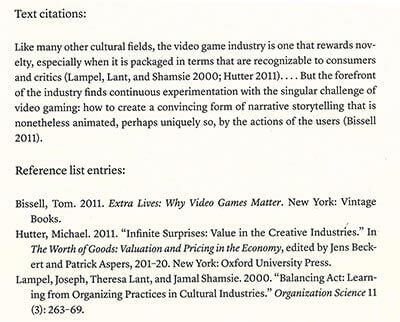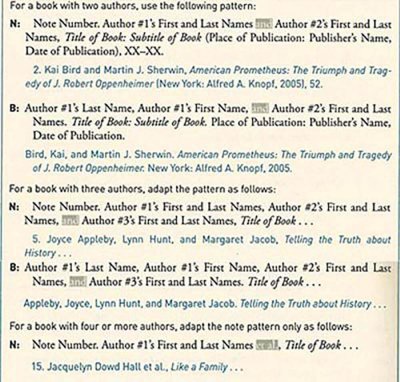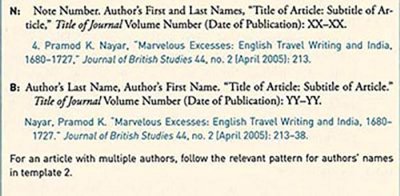Definition: Chicago Style Referencing
The Chicago style citation is extremely flexible as it unites the two main referencing styles (footnotes or author-year system) in one manual of style.
When writing longer academic texts, the use of footnotes for referencing is preferred since author-year systems are usually without footnotes. However, the Chicago style citation proposes an additional possibility that renders this system even more flexible: except with additional comments/remarks are added to the economical author-year system.
A Preface to Chicago Style Citation
Choosing a citation style is part of the process of writing your bachelor’s thesis or master’s thesis. You have to decide between putting your source citations into footnotes (notes-bibliography style) or in parentheses right after the quote (author-date system). The Chicago style citation system allows for both.
In essence, all systems have the same purpose: to guarantee that it is always clear to the reader which parts of your texts are quotations and which are your own interpretations/ideas.
Recommended: How to write an abstract
FAQ's
The Chicago style, also called the Turabian style, of citation is an extremely flexible citation style. It unites the two main referencing styles (footnotes and author-year system) in one manual style of citation. This entails using footnotes or endnotes to reference pieces of work in the research paper or essay. In addition, a superscript number is placed after a quote or a paraphrase used to cite from a source.
The Chicago style is mainly utilized in the fields of history, business, and fine arts. This is due to the notes and bibliography style of citing sources for academic writing with numbered footnotes or endnotes. It usually takes the following format in-text: (Howard said “The theory was scientific”.1). The numbered superscript is then cited again in the reference list or bibliography at the end as follows: (Howard, James, The History of Homosapiens, (New York, Mulaney, 2010),2.).
As with other citation styles, the Chicago style citation is important for numerous reasons. Notably, it allows the writer to give credit to the source of information they used in completing a dissertation or research paper. It also provides some credibility to the author’s work because it shows the reader that the author has conducted adequate research on the topic.
Although Harvard referencing and the Chicago style perform similar tasks, they differ in a few ways. The main differences are their domain of usage and the subtle difference in their formatting. Harvard referencing is used for humanities, natural or social sciences writings while the Chicago style is mainly used in the fields of history, business, and fine arts.
The basic format of the Chicago style incorporates two main referencing styles (footnotes and author-year system) into one manual style of citation. Below are some examples of the in-text citations and the reference list/bibliography citations. You can find many more examples down below on this article.
An example of the in-text format is: (Howard said, “The theory was scientific.”1).
An example of the citation in the reference list or bibliography is: (Howard, James, The History of Homosapiens, (New York, Mulaney, 2010),2.).
Examples
A) Author-date referencing in Chicago style citations
First, we will look at the parenthetical author-date system of Chicago style citations. “The author-date system is used by many in the physical, natural and social sciences and is recommended by Chicago for works in those areas” (Chicago Manual of Style 2017: 893). If you use Chicago Style Citation, every quotation (direct and indirect) must be followed by a source citation in parentheses, also called a ‘short reference’ (cf. Stickel-Wolf & Wolf 2013: 235). A detailed source citation can be found in the reference list.

A citation in the text in Chicago style citation includes author and year of publication (no intervening punctuation here) and relevant page numbers after a comma, e.g. ‘(Johns 1998, 623)’ (cf. Turabian 2007: 137).
B) Chicago bibliography style: Referencing with footnotes
The second main citation system described in the Chicago style citation manual of style is the bibliography style. As opposed to putting short citations in the text, in this Chicago style citation system source citations are listed at the bottom of the page. Superscripts in ascending numbers refer to the corresponding footnote with the source citation.

Recommended: How to cite a book
These templates present an overview of notes and bibliography entries for the most commonly cited sources (books with one or several authors, book chapters, and journal articles) in Chicago style citation (Turabian 2007: 143-145).
Single Author or Editor

Multiple Authors

Author(s) plus Editor or Translator

Edition Number

Single Chapter (Edited Book)

Journal Article in Print

Journal Article Online

Full details in footnotes as laid out here must only be provided on first mention of a work cited in Chicago Style Citation. If cited again, only a short form is used:
1. Stuart Shea, Wrigley Field: The Long Life and Contentious Times of the Friendly Confines (Chicago: University of Chicago Press, 2014), 51-52.
2. Shea, Wrigley Field, 138.
(Second mention: Author’s surname, Short form of title/no subtitle (to avoid repetition, the title of the work can also be omitted if a work is cited multiple times), page number).
Please note: You may have come across the abbreviation ‘ibid’, which means ‘in the same place’, and refers, to a work cited in the preceding note (e.g., ‘Ibid., 18’ instead of ‘Morrison, 18’). The Chicago style citation manual strongly discourages the use of ‘ibid.’ (cf. Chicago Manual of Style 2017: 759-760).
Chicago style citation author-date referencing in our BachelorPrint blog
It must be apparent to you now that we are also using a Chicago style citation author-year system with short citations in the text in this blog. You can find the sources quoted at the bottom of the page of each text.
Here, you can find templates for reference list entries and parenthetical citations (author-date system) using Chicago style citation for books with one and multiple authors, book chapters, as well as journal articles (Turabian 2007: 218–220).
Single Author or Editor

Multiple Authors

Author(s) Plus Editor or Translator

Edition Number

Single Chapter (Edited Book)

Journal Article in Print

Journal Article Online

The basic structure for each reference list entry in Chicago style citation looks like this: Author’s Last Name, Author’s First Name. Date of publication. Title: Subtitle. Edition. Place of Publication: Publisher’s Name.
Recommended: Harvard Referencing
Author-Date System or Footnotes?
Proper referencing is the key for academic writing. You have to make clear where the boundaries are between your own ideas and somebody else’s ideas. Since the Chicago style citation offers you a choice between the two most common citation systems, namely footnote or parenthetical referencing, you have to figure out which of the Chicago style citation systems is most suitable in your particular case.
Chicago style citation & more
The following overview lists the most common citation systems besides the Chicago style citation system and also gives you a good idea of the fields of study they are predominantly used in. The term Harvard style serves as an umbrella term for the author-date concept (cf. Kruse 2010: 116).
 |
 |
|
Premium hardback binding |
Standard hardback binding |
|
From CAN$32.90 |
From CAN$25.90 |
|
| Color | Black, bordeaux red, dark blue, dark green | Black, dark blue, dark green, bordeaux red |
| Areas embossed | Front cover and spine | Front cover and spine |
| Embossing Colors | Gold, silver, black | Gold, silver, black |
| Ribbon | Yes | Yes |
| Corners | Yes | Yes |
| Optics | Textured, matte, leather look, soft | Smooth, shiny, leather look, textured |
| Number of pages | 10 - 370 | 10 - 370 |
There are manuals for most of the above citation systems – Chicago style citation is one of them. Even though the term Harvard referencing is widely used, there is no actual manual. This is why the Chicago style citation has an important role to fulfil: if you are asked to use Harvard referencing, you will have to consult either the Chicago style citation manual or the APA Manual of Style.
The Chicago Manual of Style:

Chicago style citation: author-date system vs. referencing with footnotes
The Table below shows pros and cons of the author-date system compared referencing with footnotes using Chicago style citation (cf. Franck & Stary 2009: 193; Kornmeier 2013: 283; Krämer 2009: 148ff.; Kruse 2010: 118f.; Rossig & Prätsch 2005: 133, 135; Stickel-Wolf & Wolf 2013: 235f.; Theisen 2013: 167; Winter 2004: 88).
| Author-date system in Chicago style citation | Referencing with footnotes in Chicago style citation | |
| Advantages | - saves time: short references in the text are directly linked to the reference list so there is no doubling of full references - you are not tempted to transfer additional comments which seem interesting but are in fact redundant into the footnotes - a basic word processing programe is sufficient |
- full references are given when sources are quoted for the first time: easy identification of sources - Allows using footnotes for comments, examples, references to further readings, etc. - The reader can judge sources more easily and does not have to look them up in the reference list |
| Disadvantages | - short references can mask the nature of the source - only academic sources should be used since sources cannot be described in detail - Comments/remarks are not wanted because they might fragment the text; however, such comments might also be useful and even necessary additions |
- Creating footnotes and formatting them is time consuming - Doubling of full references, because it is mandatory to provide a reference list in most cases - Too many footnotes with comments or examples take up additional footnote space next to references and disrupt the reading flow |
| Chicago style citation suitable for | The Chicago style citation recommended for shorter academic papers e.g. project proposals or seminar papers. | The Chicago style citation recommended for longer papers where footnotes with comments are a valuable addition and many sources are cited, e.g. dissertation, Master’s thesis. |
Chicago Style Benefits
In actual practice, you might have seen a mixed system with parenthetical references in the text and footnotes for additional comments only – and not for source citations. Theisen claims that this is messy and not aesthetic (cf. 2013: 166), but there are advantages to it and the Chicago style citation manual recommends this as good practice (cf. 2017: 768).
- Footnotes can be used for comments/examples and give your text more substance, but you can still use the more economical author-date system.
- Footnotes with additional remarks are merely an additional feature of the Chicago style citation author-date system.
- Source citations (in the text) and additional comments (in footnotes) are clearly separated and the reader will benefit from this. He/she knows that the footnote space contains additional remarks only
In a Nutshell
- Chicago style citation offers a choice between referencing with footnotes (bibliography style) and parenthetical references (author-date system).
- One system of the Chicago style citation might be more suitable for a particular field of study than the other and it is best to consult your supervisor if you are unsure about which system to use
- Both Chicago style citation systems use the same pieces of information, but elements are presented in a different order and the punctuation differs.
- The Chicago Manual of Style serves as a reference and you should model your source citations according to the rules therein.
- Recommendation: Chicago style citation is highly flexible because the footnote system (only for additional remarks) can be added to the author-date system.
References
Franck, Norbert & Joachim Stary. 2009. Die Technik des wissenschaftlichen Arbeitens. 15th ed. Paderborn: Ferdinand Schöningh.
Kornmeier, Martin. 2013. Wissenschaftlich schreiben leicht gemacht – für Bachelor, Master und Dissertation. 6th ed. Bern: Haupt.
Krämer, Walter. 2009. Wie schreibe ich eine Seminar- oder Examensarbeit? 3rd ed. Frankfurt: Campus.
Kruse, Otto. 2010. Lesen und Schreiben – Der richtige Umgang mit Texten im Studium. Konstanz: UVK Verlagsgesellschaft.
Rossig, Wolfram E. & Joachim Prätsch. 2005. Wissenschaftliche Arbeiten. 5th ed. Weyhe: PRINT-TEC.
Stickel-Wolf, Christine & Joachim Wolf. 2013. Wissenschaftliches Arbeiten und Lerntechniken – Erfolgreich studieren – gewusst wie! 7th ed. Wiesbaden: Springer Gabler.
Turabian, Kate L. 2007. A Manual for Writers of Research Papers, Theses, and Dissertations – Chicago Style for Students and Researchers. 7th revised ed. Chicago & London: The University of Chicago Press.
The Chicago Manual of Style. 2017. 17th ed. Chicago & London: The University of Chicago Press.
Theisen, Manuel René. 2013. Wissenschaftliches Arbeiten – Erfolgreich bei Bachelor- und Masterarbeit. München: Franz Vahlen.
Winter, Wolfgang. 2005. Wissenschaftliche Arbeiten schreiben. 2nd ed. Frankfurt: Redline Wirtschaft.

